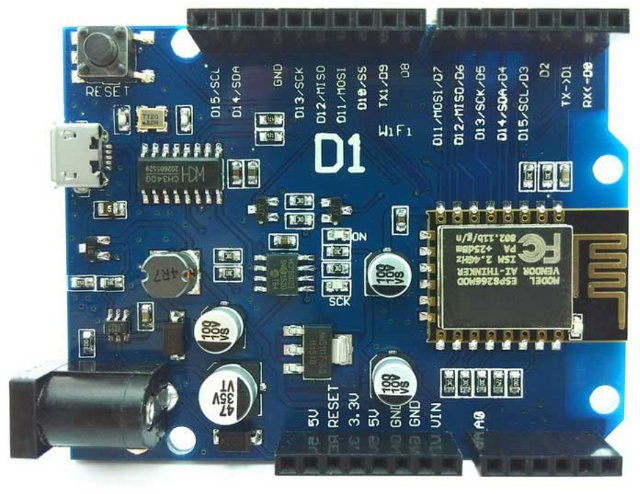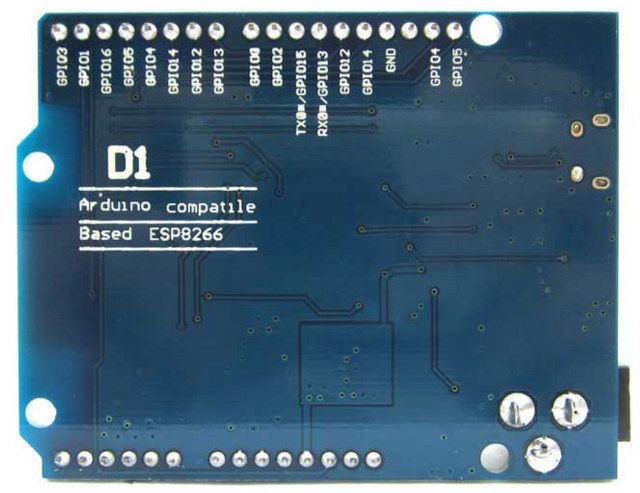We’ve already seen the Arduino IDE supports ESP8266(-EX) WiFi SoC, and some companies have designed Arduino shields for ESP8266 modules, but so far I had never seen an ESP8266 board with Arduino UNO form factor supporting Arduino shields, and that’s exactly what showed up in DX new arrivals RSS feed with a white label ESP-12E UNO board selling for $11.75 including shipping.

The “D1” board has the following specifications:
- ESP8622 Module – AI-Thinker ESP12-E module (as found in NodeMCU) based on ESP8266-EX SoC @ 80 or 160 MHz with 4MB flash
- Connectivity – 802.11 b/g/n with PCB antenna. Supports station / softAP / SoftAP + station modes, WPA/WPA2 security.
- I/Os
- 11x Digital I/O pins
- 1x Analog Input pin
- I/O logic level: 3.3V
- ADC pin (A0) input voltage: 0-3.3V
- Debugging – Via micro USB using CH340G USB-TTL serial chip
- Misc – Reset button
- Power Supply – 6-24VDC via DC jack, 5V via micro USB port
- Dimensions – 7 cm x 5.4 cm x 1.5 cm

The board is said to come with a user’s manual in English, and DealExtreme provides a download link, but there’s only a guide to install CH340 in Windows. The board is supported by Arduino 1.6.5 IDE, and the firmware can be updated over WiFi.
Beside DealExtreme, you can also find ESP8266 D1 board on Aliexpress for $9 and up including shipping, and even less (about $8) if you order 10 pieces or more.

Jean-Luc started CNX Software in 2010 as a part-time endeavor, before quitting his job as a software engineering manager, and starting to write daily news, and reviews full time later in 2011.
Support CNX Software! Donate via cryptocurrencies, become a Patron on Patreon, or purchase goods on Amazon or Aliexpress. We also use affiliate links in articles to earn commissions if you make a purchase after clicking on those links.




Nice, just wondering if you can put 5V arduino shields on top of it. The ESP is mostly in 3.3V, and I think some voltage regulator on the board.
I’m wondering if this can do host wi-fi. Probably not but it still sounds like a great IoT device which you can connect to a router to acess you sensors or whatever.
@zoobab
The specs say “I/O logic level: 3.3V”, so I assume it’s not some sort of magic 5V-tolerant ESP-12E module on there, and the arduino-pinout PCB clearly just routes the arduino IO pins straight up to module, so I imagine 5V on a shield I/O pin would fry it. And yet they peg the IOREF pin at 5V (according to the silkscreen), meaning it’s asking shields to send it 5V, even if the shield would have supported 3V3.
I’m not sure this is a terribly well thought-out design.
@Marius
If by host you mean AP, then yes.
@John S. @zoobab
Not magical 5v I/O. I/O is 3.3v. The 5v pin is connected directly to the USB 5v and input for the voltage regulator.
Cool, but I’m still waiting for BLE + WiFi version.
Also on Electrodragon for 7.15 Euros: http://www.electrodragon.com/product/d1wifi-arduino-based-board-arduino-nodemcu-compatible/
WeMos D1 Wiki: http://www.wemos.cc/wiki/doku.php?id=en:d1
$8.49 (on sale?):
http://www.banggood.com/WeMos-D1-WiFi-ESP8266-Development-Board-Compatible-Arduino-UNO-Program-By-Arduino-IDE-p-1011870.html
Almost all the reviews are v positive.